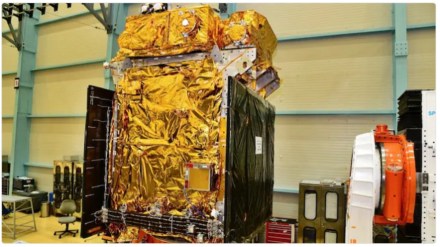Aditya-L1, India’s pioneering solar study mission, to be launched by the Indian Space Research Organisation (ISRO), is set to redefine our understanding of the celestial sphere and the enigmatic star that fuels life on Earth. The mission according to the space agency will take off later this month or early September.
Orbiting the Enigmatic Lagrange Point 1 (L1)
Aditya-L1’s mission takes it to the forefront of space exploration, as it circles around the Lagrange point 1 (L1) – a celestial equilibrium between the Earth and the Sun, situated approximately 1.5 million kilometers away from our planet. This unique vantage point offers an unobstructed view of the cosmic dance between the Sun and Earth, and Aditya-L1 is primed to unveil its secrets.
The Countdown to a Stellar Journey
With every meticulous detail attended to, Aditya-L1 prepares for its grand launch. The ISRO, has entrusted the responsibility of this awe-inspiring launch to their steadfast PSLV rocket. A symphony of precision unfolds at the Satish Dhawan Space Centre SHAR (SDSC SHAR) in Sriharikota, where history will witness Aditya-L1’s spectacular ascent into the cosmos.
ISRO’s Tweet: Echoes across the Cosmos
ISRO, announced the imminent launch of Aditya-L1, christening it the first Indian space-based observatory dedicated to unraveling the Sun’s mysteries. A satellite, crafted at the U R Rao Satellite Centre (URSC) in Bengaluru, embarks on its journey to the SDSC-SHAR in Sriharikota, ready to be hurled into the cosmos.
Embarking on a Solar Odyssey
Delving into the heart of Aditya-L1’s mission reveals its noble objective: to comprehend the secrets of the Sun. Positioned within a halo orbit around the L1 point, Aditya-L1 ushers in a new era of solar exploration. This voyage will commence with the PSLV rocket propelling the spacecraft to a low Earth orbit. Subsequently, an onboard propulsion mechanism guides Aditya-L1 into an elliptical orbit, paving the way for its majestic journey towards the L1 point.
The Enchanting Phase of Cosmic Transition
As Aditya-L1 navigates the celestial seas towards L1, it escapes the Earth’s gravitational influence, embarking on the cruise phase. This enchanting passage heralds the spacecraft’s entry into a colossal halo orbit around the Lagrange point. This cosmic ballet spans four months, a testament to the meticulous planning and dedication that underpins Aditya-L1’s mission.
Unveiling the Sun’s Uninterrupted Gaze
One of Aditya-L1’s prime advantages stems from its celestial positioning. Nestled within the hold of the L1 point, the satellite stays in the uninterrupted gaze of the Sun. Unveiling this uninterrupted vista, it escapes the clutches of occultation and eclipses, ensuring an unblemished view of the Sun.
Witnessing Solar Dynamics Unfold
Aditya-L1’s mission extends beyond observation, delving into the realm of real-time solar dynamics. As it witnesses solar activities, it captures the intricate interplay between the Sun and the cosmic milieu. The ethereal dance of space weather unfolds before its sensors, enabling a comprehensive understanding of the cosmic forces that shape our universe.
Instruments of Discovery: Illuminating Solar Layers
The spacecraft is laden with seven payloads, each a sophisticated tool for unraveling the Sun’s mysteries. With an unwavering resolve, Aditya-L1 peers into the photosphere, chromosphere, and the Sun’s corona. These payloads, armed with electromagnetic, particle, and magnetic field detectors, usher us into an era of unprecedented solar exploration.
Decoding Solar Enigmas: The Payloads
Visible Emission Line Coronagraph (VELC): Embarking on a Visual Journey of the Solar Corona.
Solar Ultraviolet Imaging Telescope (SUIT): Illuminating the Solar Photosphere and Chromosphere.
Solar Low Energy X-ray Spectrometer (SoLEXS) and High Energy L1 Orbiting X-ray Spectrometer (HEL1OS): Deciphering X-ray Whispers from the Sun.
Aditya Solar wind Particle Experiment (ASPEX) and Plasma Analyser Package For Aditya (PAPA): Unraveling the Solar Wind’s Secrets.
Intertwining with Cosmic Magnetic Fields
Amidst the marvels, the Advanced Tri-axial High-Resolution Digital Magnetometers stand as sentinels, unraveling the intricate magnetic tapestry that threads through the interplanetary medium.
The Aditya-L1 mission, bearing these seven payloads, heralds a new era of cosmic exploration, illuminating the Sun’s enigmatic aura. In a symphony of science and engineering, India’s scientific prowess resonates throughout the cosmos, beckoning us to a greater understanding of the universe’s most captivating luminary.
The Aditya Solar wind Particle Experiment (ASPEX) and Plasma Analyser Package for Aditya (PAPA) will analyse the electrons and protons in the Solar wind or particles. It will also study the energetic ions.
The Advanced Tri-axial High Resolution Digital Magnetometers will study the interplanetary magnetic field at L1 point.
